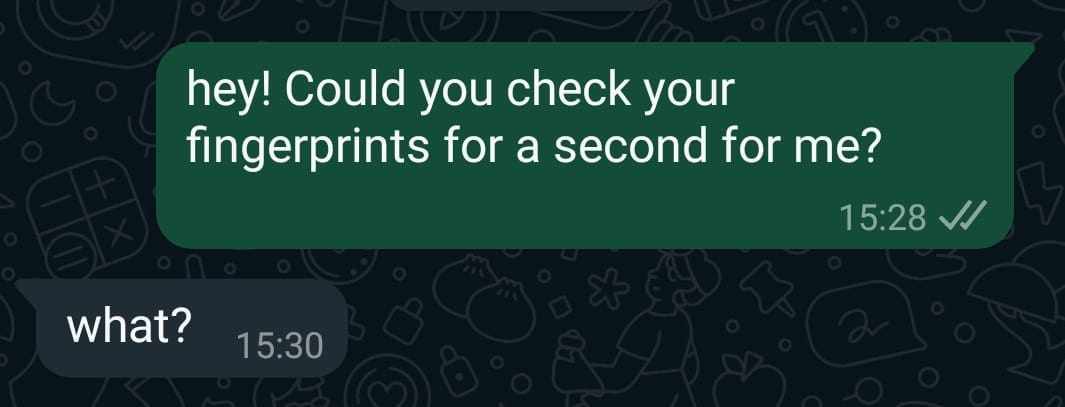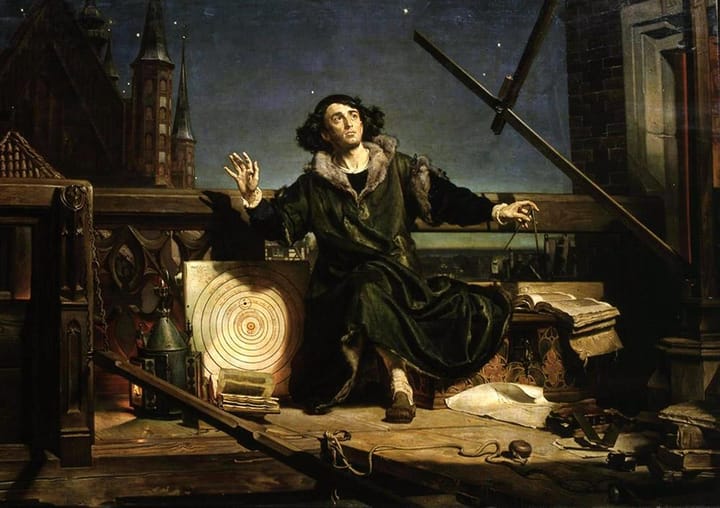Are fingerprints symmetric?

While I was in the library, staring into my hands, wondering why I thought a PhD was a good idea, I noticed something for the first time.
My fingerprints were symmetric between hands.
Looking closer, I could tell that the details of the valleys and ridges differed between the fingers, but the rough map was a mirror of the opposing finger. They were reflections up to where on the finger the swirls were and in what direction they were in.
Now, I know you are either checking or about to check yours, but please hold it in just a little longer and do it while you fill in the survey down the page! You could contribute to new science!
Is symmetry between fingers a general property of fingerprints?
I decided to have a little fun and try some old-school science. Instead of googling, I asked some people I knew if they also had symmetric prints.
I texted three friends and my mum. Soon, with a sample size of five, 100% of respondents had symmetric prints.
At this point, I decided it was obviously true that fingerprints are this way and gave the question a google.
Shockingly, it turned out that it was not generally true.
And in fact, the next two people I asked did not have totally symmetric fingerprints.
However, I was now curious. How untrue was it?
On each of my hands, I have two loops and three whorls.
This is not odd, given that loops and whorls are the most common print types. Loops occur 60% of the time, whorls 35% of the time and arches 5%.
Now, let me illustrate how unlikely it is that prints on opposing fingers do not have a relationship.
Assuming that if two fingers happen to have the same category, we will count them as mirrored, then the probability of a single finger being mirrored would be 0.6\(^2\) + 0.35\(^2\) + 0.05\(^2\) = 0.485. So, being charitable, the probability of seeing a match would be just shy of 50% for a single finger. (This ignores that many prints in the same category would not look roughly mirrored to us. Including this would make a match even less likely.)
Getting a match on all five fingers is at least as unlikely as flipping a coin five times and getting five heads. This is a 1 in 32 chance.
That means the probability of my run of five yeses was less than 1 in 32\(^5\), or 1 in 33 million.
So, it's clear that fingerprints correlate with the print on the opposing finger unless I should have bought a lottery ticket instead of staring at my hands that day.
This leads me to two simple questions:
What proportion of people actually have symmetric fingerprints?
and
What is the probability of two opposing fingerprints being symmetric?
Surprisingly, I have not found the answers to these questions in the literature! (Edit: I now believe this topic was studied in the 60s. I'm still trying to track down figures, though)
This is it, our big opportunity to contribute to science.
I have embedded a Google form onto this page that you can fill in with the type of print you have on each finger and whether they are mirror images.
This is linked to a spreadsheet which will automatically update with new responses. If you scroll past the form, you will find the results as they currently stand.
The two big results are the proportion of respondents who have (roughly) totally mirrored prints on their hands and the proportion of fingers that are mirrored.
Note that it may take a while for your results to be displayed in the graphs, so you might want to check back later to see if you changed the results.
I'm excited. Let's do it:
Results!
Let’s start by looking at how converged the results currently are. This first pie chart indicates the proportions of the three types of print in our data. If the proportions are in the ranges: loops 60-65%, whorls 30-35% and arches 5-10% then we have reason to suspect the data has begun to converge.
This is the total number of respondents:
Now, let's get straight to the good stuff!
What proportion of people have totally symmetric fingerprints:
Remember, if fingerprints were independent, the slice representing totally symmetric prints would be 1/32 nd of the whole pie (~3%).
So the empirically estimated probability for getting 5 yeses to my "are your prints all symmetric question" currently stands at:
Note that if fingerprints were independent, this value would be 0.0000030303%.
What is the probability of having a mirrored print on a finger:
For independent fingerprints, we expect less than half of the pie to be mirrored.
Those who have symmetry will be given more, from those who have little, even what they have will be taken away:
Now, if fingerprints on different fingers on a person's hand were independent, that is, the probability of having a match on your pinky, say, was unchanged by discovering all your other fingers matched, then the likelihood of having a complete set of matches is:
Instead, we have:
At the time of writing, these probabilities are quite different, with the observed probability around twice that predicted by assuming independence. This would mean that some symmetry implies you will find more symmetry.
Does that mean there is some kind of symmetry coefficient for humans? That if a person is symmetric in some aspects, they are likely to be symmetric in others, perhaps their nose, eyes, toeprints etc?
Yes. This is a consequence of developmental biology. I don't pretend to understand it, but it's interesting that we managed to rediscover it here.
Among fingers, the index stands alone, radical and unconventional:
Is the probability of a match independent of which finger we are studying? It appears not. At the time of writing, the index stands out as particularly unconformist. It prevented almost half the participants from reaching a complete set.
The symmetric are special? No
Breaking down the number of matches, symmetric or almost symmetric sets of fingerprints are a majority. The rarest individuals are those who can see no or only a single mirroring between their hands:
Future work
I would like to see how this result fits into the existing biological symmetry literature. To do this well, I think it would be nice to have a more rigourous method than a survey.
One possibility would be to use a fingerprint dataset with all 10 fingers on record (get in touch if you know of such a database). Machine vision could then identify the subcategory of the loop, whorl or arch the print belongs to. Then, we could study the symmetry statistics between the same individual's hands and fingers.
It would also be interesting to extend the survey somehow. It would be good to indicate if there is a genetic link between participants, perhaps a survey for both a parent's and child's prints, to see how strong the genetic component is.
My colleague, Grace Aquilina, has also suggested investigating the effect of handedness on the results, which would also be an interesting avenue of research.
So there you have it—science in action. I hope you have a brilliant day!



Comments ()